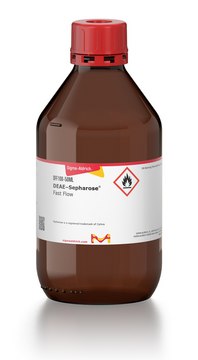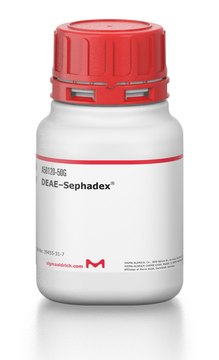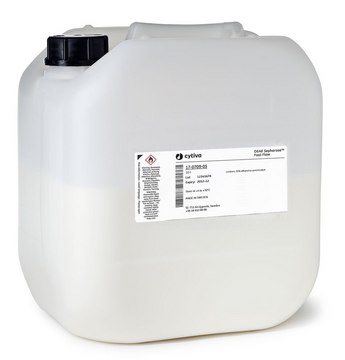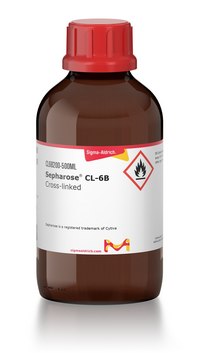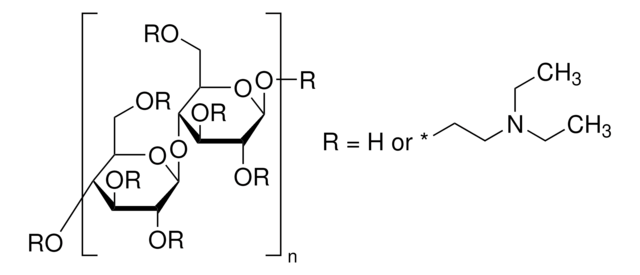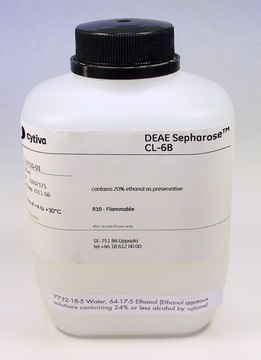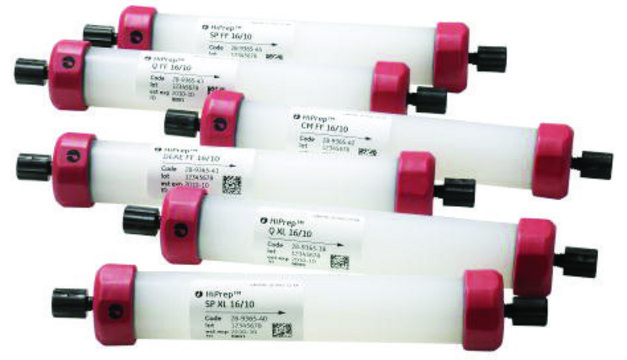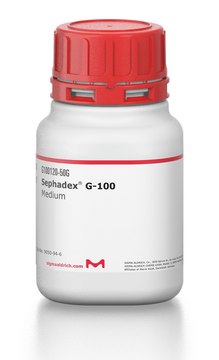DCL6B100
DEAE–Sepharose™
CL-6B
Synonym(s):
Diethylaminoethyl–Sepharose™
Sign Into View Organizational & Contract Pricing
All Photos(1)
About This Item
Recommended Products
Quality Level
form
suspension
technique(s)
affinity chromatography: suitable
matrix
6% cross-linked agarose
bead size
45-165 μm
pore size
~4,000,000 Da exclusion limit
pH
3—12
capacity
130-170 μeq/mL binding capacity (gel volume)(gel volume)
Looking for similar products? Visit Product Comparison Guide
General description
DCL6B100-500ML′s updated product number is GE17-0710-01
Application
DEAE-Sepharose® is used in affinity chromatography, protein chromatography and ion exchange chromatography. DEAE-Sepharose™ has been used to study pathogenesis of human disease and to develop a new assay for detecting the toxins of pathogenic strains of Clostridium difficile.
Legal Information
DEAE-Sepharose is a registered trademark of Cytiva
Sepharose is a trademark of Cytiva
replaced by
Product No.
Description
Pricing
Signal Word
Warning
Hazard Statements
Precautionary Statements
Hazard Classifications
Flam. Liq. 3
Storage Class Code
3 - Flammable liquids
WGK
WGK 1
Flash Point(F)
100.4 - 109.4 °F
Flash Point(C)
38 - 43 °C
Personal Protective Equipment
dust mask type N95 (US), Eyeshields, Gloves
Regulatory Information
危险化学品
Choose from one of the most recent versions:
Already Own This Product?
Find documentation for the products that you have recently purchased in the Document Library.
R K Sinha et al.
Vaccine, 15(6-7), 689-699 (1997-04-01)
Six different secretory proteins of molecular weights (15, 26, 30, 41, 55 and 70 kDa) were isolated from 8-day-old culture filtrate of Mycobacterium tuberculosis H37Ra using different column chromatography techniques. These proteins were further examined for their ability to induce
I Yu Bakunina et al.
Biochemistry. Biokhimiia, 67(6), 689-695 (2002-07-20)
An alpha-N-acetylgalactosaminidase IV able to remove blood type specificity of human A(II)-erythrocytes and not effecting B(III)-erythrocytes was isolated from the marine bacterium Arenibacter latericius KMM 426T. The alpha-N-acetylgalactosaminidase IV preparation exhibits high activity during inhibition of hemagglutination with blood group
M A Heine et al.
Molecular biology of the cell, 4(11), 1189-1204 (1993-11-01)
Epitope-tagged Xenopus nucleolin was expressed in Escherichia coli cells and in Xenopus oocytes either as a full-length wild-type protein or as a truncation that lacked the distinctive carboxy glycine/arginine-rich (GAR) domain. Both full-length and truncated versions of nucleolin were tagged
J J Wheeler et al.
Gene therapy, 6(2), 271-281 (1999-08-06)
A detergent dialysis procedure is described which allows encapsulation of plasmid DNA within a lipid envelope, where the resulting particle is stabilized in aqueous media by the presence of a poly(ethyleneglycol) (PEG) coating. These 'stabilized plasmid-lipid particles' (SPLP) exhibit an
M Vasseur
Bioscience reports, 9(3), 341-346 (1989-06-01)
The rabbit intestinal sucrase-isomaltase complex has been purified to homogeneity after solubilization with Triton X 100 followed by chromatography on DEAE Sepharose CL 6B and a second solubilization with papain. After hydrophobic chromatography on Octyl Sepharose CL 6B, separation from
Our team of scientists has experience in all areas of research including Life Science, Material Science, Chemical Synthesis, Chromatography, Analytical and many others.
Contact Technical Service